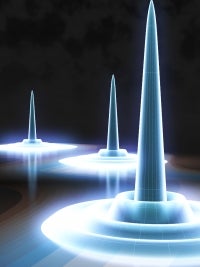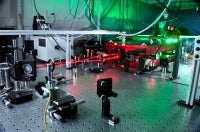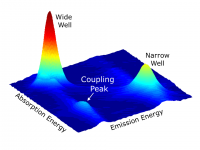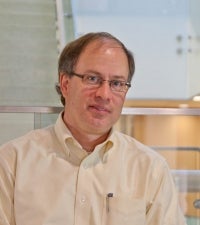Our work on quantum droplets, a.k.a. “dropletons”, was selected for inclusion in the special issue of Optics and Photonics News on “Optics in 2014.”
Related Links: Optics and Photonics News Article

Our work on quantum droplets, a.k.a. “dropletons”, was selected for inclusion in the special issue of Optics and Photonics News on “Optics in 2014.”
Related Links: Optics and Photonics News Article
Andy Almand-Hunter successfully defend his thesis, “Quantum-Optical Spectroscopy of Excitonic Correlations in Gallium Arsenide Quantum Wells” on November 14th. Congratulations Andy!
Dropletons were featured in an article in Science News on quasiparticles.
Related Links: Article
Electrons tightly confined to a two-dimensional sheet in a semiconductor nanostructure have been demonstrated as an excellent platform for nanoscale devices and quantum information applications; however, interactions between electrons typically hinder device performance by stimulating chaotic behavior. In this work, published March 7th in Physical Review Letters, we demonstrate that instead of being detrimental, these many-body
interactions can synchronize the electrons to act in unison, and this coherent behavior could be exploited for novel quantum devices. Electronic interactions are studied using optical two-dimensional coherent spectroscopy, a technique that uses a series of ultrafast laser pulses to excite specific electronic transitions in the nanostructure. The spectral content of the emitted light is analyzed while systematically varying the delays between the excitation pulses, which yields spectral information not accessible using other techniques. These results provide unique insight into the fundamental nanoscale interactions responsible for the collective behavior of the electronic system. The coherent many-body signals revealed in this work are comparable in strength to other quantum systems developed for quantum information applications, demonstrating the promise of a two-dimensional electron gas in a semiconductor nanostructure as a new avenue for coherent opto-electronic devices.
The Optical Society of America has launched a new high impact optics journal, Optica.

Theoretical structure of a quantum droplet showing possible locations of the positively charged “hole” with respect to a negatively charged electron located in the center (which is also the most likely location of the hole). A hole is like a bubble created when an electron in GaAs is excited by light. Credit: The Cundiff group and Brad Baxley, JILA
When Andy Hunter and his colleagues in the Cundiff group shined a laser on a sample of gallium arsenide (GaAs), the last thing they were expecting to create was a fog of liquid-like quantum droplets. The droplets are a new, stable form of matter much like an ordinary liquid—with one key difference.
Unlike normal everyday liquids, the droplets contain charged particles. The particles are negatively charged electrons and positively charged “holes.” Holes are like bubbles created when electrons in GaAs are excited by light.
When it discovered the quantum droplets, the Cundiff group was actually investigating the use of intense laser light to generate biexcitons, which are molecule-like structures in GaAs made of two excitons. Excitons are hydrogen-like quasi particles made of an electron and a hole.
“But the experiment didn’t behave at all in the way we expected,” Hunter said. “We expected to see the energy of the biexcitons increase as the laser generated more electrons and holes. But, what we saw when we did the experiment was that the energy actually decreased!”
The energy decrease meant that the researchers certainly were seeing something other than biexcitons. In fact, they weren’t sure what they had made. At this point, experimentalists Hunter, former research associate Hebin Li, and Fellow Steve Cundiff consulted their theorist colleagues at Philipps-University Marburg in Germany.
The German collaborators came up with the idea that the experimentalists had made quantum droplets. A quantum droplet is a structure containing multiple electrons and holes (for example, 4, 5, or 6 of each) that is in between that of a traditional atom with positively charged nucleus surrounded by negatively charged electron(s) and an older model of the atom that viewed it as a positively charged sphere with electrons embedded in it. The droplets behaved quantum mechanically because they contain only a few electrons and holes.
Quantum droplets, also known as dropletons, aren’t made up of multiple excitons because the electrons and holes in them are not bound into pairs. In a quantum droplet, all of the electrons interact equally with all of holes and vice-versa. In an excitonic molecule, such as a biexciton, the electrons and holes form excitons, which then form molecules. In this case, each electron primarily interacts with a single hole. It’s completely different with quantum droplets.
According to the quantum-droplet theory calculations (as represented in the figure), the electron is in the middle of the tall structure in the middle of the droplet. The hole and the electron are most likely right on top of each other. However, the hole could also be just above, just below, or even next to the electron. The next most likely location of the hole is somewhere on the first ring. The third most likely location for the hole is on the second ring. The least likely location is in the gaps between the rings. As the density of electrons and holes increases inside a droplet, so too does the number of rings, as shown in the background of the figure.
The experimental observations made by Hunter and his colleagues fit perfectly with the new theory. The researchers realized that they had inadvertently created a quantum fog of electrons and holes in close proximity to one another. In the process, they had discovered a new quasiparticle as stable as an atom or a solar system. This story is featured on the cover of the February 27 issue of Nature.
Related Links: Article

The JILA MONSTR (Multidimensional Optical Nonlinear SpecTRometer) used to study the coupling of multiple excitons in quantum wells. Credit: Brad Baxley, JILA
Real-world quantum mechanics may not always work exactly like the simple picture presented in textbooks, according to observations made by research associate Gaël Nardin and his colleagues in the Cundiff group.
In a recent experiment (described online in Physical Review Letters this week), the group discovered evidence of coupling between particles in semiconductor quantum wells that hadn’t been predicted
by simple textbook calculations. Semiconductors are materials whose electrical conductivity increases when light shines on them, and quantum wells are extremely thin layers of semiconductor materials. These layers are so thin that tiny particles in them exist as

Experimental results of the Cundiff group’s “real-world” coupling experiment. This 2D spectrum shows a coupling peak due to the interactions of many particles in adjacent quantum wells. Credit: Gaël Nardin (Cundiff group), JILA
waves and their behavior is dominated by quantum mechanics. Consequently, quantum wells are ideal for studying the strange properties of quantum physics, including some unexpected particle couplings.
The coupled particles studied by Nardin and his colleagues were excitons, which are hydrogen-like quasi particles consisting of negatively charged electrons bound to positively charged “holes” in semiconductors. Holes are like bubbles created when electrons are excited by light. Excited electrons and holes then pair together to form excitons when laser light interacts with quantum wells.
The researchers created excitons in two adjacent quantum wells, one wide and the other narrow. Then they probed the interactions of the excitons with a precision optical instrument called the JILA MONSTR (Multidimensional Optical Nonlinear SpecTRometer). The research team included Nardin, newly minted Ph.D. Galan Moody, graduate students Rohan Singh and Travis Autry, former research associate Hebin Li, Fellow Steve Cundiff, and François Morier-Genoud of Switzerland’s École Polytechnique Fédérale de Lausanne.
The researchers expected to see what the textbooks predicted: coupling between the two quantum wells due to the wave-like nature of the electrons and holes in the wells. Because they are waves, the electrons and holes can tunnel through the barrier between the wells; in contrast, if they were governed by classical physics they would have had to jump over it.
At first, the experiment confirmed the presence of coupling between the narrow and the wide quantum wells. For example, a coupling peak appears clearly in the two-dimensional measurement produced by the JILA MONSTR, shown in the figure. However, a careful analysis of the experimental results revealed that the coupling had not originated from textbook quantum coupling, but rather from the collective interaction of multiple excitons in both quantum wells. This exciting finding implies that scientists should plan on including the interactions of many particles to reproduce what Mother Nature is actually doing in the quantum world.
The new picture of coupling between quantum wells may help scientists better understand light harvesting in plants and bacteria. In light harvesting, energy is transferred between pigments that can be modeled as quantum wells because electrons can hop from one pigment to another. This behavior is similar to what Nardin and his colleagues observed with excitons in their coupling experiment.
The Cundiff group’s fundamental research into real-world quantum coupling of many particles also promises to facilitate applied research such as the enhancement of quantum cascade lasers, which employ multiple adjacent quantum wells to produce lasing.—Julie Phillips
Related Links: Link to publication
 Steve Cundiff was named an IEEE Fellow on January 1, 2014. In electing him as a Fellow, the Board of Directors of the Institute of Electrical and Electronics Engineers, Inc. cited him “for contributions to self-referenced optical frequency combs and ultrafast nonlinear solid-state spectroscopy.”
Steve Cundiff was named an IEEE Fellow on January 1, 2014. In electing him as a Fellow, the Board of Directors of the Institute of Electrical and Electronics Engineers, Inc. cited him “for contributions to self-referenced optical frequency combs and ultrafast nonlinear solid-state spectroscopy.”
“I am delighted to share the good news with you and to congratulate you on having this distinguished individual on your staff,” said J. Roberto B. de Marca, IEEE President and CEO in a letter to Thomas O’Brian, chief of NIST’s Quantum Physics Division here at JILA.
The IEEE Fellowship is one of the most prestigious honors of the IEEE. It is bestowed upon a limited number of Senior Members who have made outstanding contributions to the electrical and information technologies and sciences for the benefit of humanity and the profession. Only about one-tenth of one percent of IEEE members become Fellows.
Source: JILA Scientific Communications
Our work on 3D coherent spectroscopy is included in the “Optics in 2013” issue of Optics and Photonics News (p. 50).
Our paper on 2D colinear optical photocurrent spectroscopy has been published in Optics Express.
